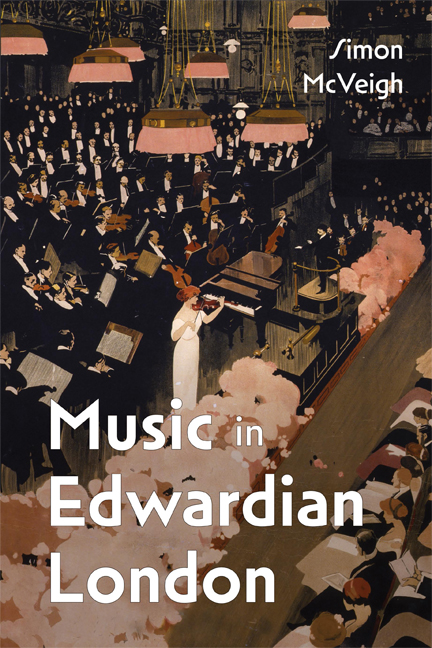Book contents
- Frontmatter
- Dedication
- Contents
- List of Illustrations
- Preface
- 1 Edwardian Soundscapes
- 2 Mapping a Musical City: Place (and Class)
- 3 Mapping a Musical City: Time (and Taste)
- 4 London as Musical Hub: Europe, America, Empire
- 5 The British Question
- 6 Britain and ‘Others’
- 7 Hidden Voices
- 8 From Battersea to Bermondsey: Suburban Music and Local Politics
- 9 London’s Music: An Overview
- Sources and Bibliography
- Index
- Miscellaneous Endmatter
1 - Edwardian Soundscapes
Published online by Cambridge University Press: 09 May 2024
- Frontmatter
- Dedication
- Contents
- List of Illustrations
- Preface
- 1 Edwardian Soundscapes
- 2 Mapping a Musical City: Place (and Class)
- 3 Mapping a Musical City: Time (and Taste)
- 4 London as Musical Hub: Europe, America, Empire
- 5 The British Question
- 6 Britain and ‘Others’
- 7 Hidden Voices
- 8 From Battersea to Bermondsey: Suburban Music and Local Politics
- 9 London’s Music: An Overview
- Sources and Bibliography
- Index
- Miscellaneous Endmatter
Summary
EDWARDIAN MUSIC. WHAT IMMEDIATELY springs to mind? Perhaps a stiff-collared Elgar and the confident swagger of Pomp and Circumstance, the splendour and authority of British tradition? Or perhaps a saucy music hall turn, a vanished world of idealised working-class culture, recalled through a nostalgic lens? Or – yet another rosy image – perhaps the folksongs and May dances of rural Merrie England?
It's all too easy to map music onto pre-conceptions of a glitteringly opulent age: the sunlit hedonism of society balls and country house weekends, that orderly society so soon to be shattered by the cataclysm of World War 1. Osbert Sitwell painted just such a picture of the role of music in the lives of pleasure-seeking Londoners in ‘the sweet and carefree atmosphere’ before the war: ‘An air of gaiety, unusual in northern climates, prevailed. Music flowed with the lightness and flash of water under the striped awnings and from the balconies… Night by night, during the summers of 1913 and ‘14, the entertainments grew in number and magnificence. One band in a house was no longer enough, there must be two, three even.’
But as historians have increasingly emphasised, the Edwardian was also a period of tumultuous social upheaval. The birth pangs of the labour movement and the marches of women suffragists were only the most visible signs of a country hurtling into modernity, sometimes painfully. At home, a constitutional crisis around 1910 clipped the wings of the landed aristocracy. Abroad, Britain's precarious empire was equally humiliated by the Second Boer War (1899–1902) and threatened by German technology and expansionism.
Music was also in transition. Far-reaching changes in British society were reflected in an ever-widening availability across social classes – while London's pivotal position internationally led to its becoming one of the centres of the new musical world. Reflecting ‘a ramshackle and amorphous society, characterised by a myriad contradictory trends and opinions’, Edwardian music often seems uncertain in direction, as well as extraordinarily diverse. It's partly this kaleidoscope that gives the period its fascination. And, if modern Britain was born in the early years of the twentieth century, this was certainly the case with regard to music as well.
- Type
- Chapter
- Information
- Music in Edwardian London , pp. 1 - 13Publisher: Boydell & BrewerPrint publication year: 2024

